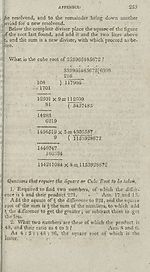Download files
Complete book:
Individual page:
Thumbnail gallery: Grid view | List view

252
APPENDIX.
another* in the order of their dates, and when two Drs. ot 1
two Crs. follow one anotlier, they are added, and the com- ^
mon title prefixed ; but if a Dr. and Cr. follow one another, ^
the less is subtracted from the greater, and the title of the
greater is prefixed to the remainder : The days are found as ?
in the former example, and they are multiplied by the re. ’•
spective balances, and the products placed in the Dr. or Cr.
product, according to the title of the balance that is multU t
plied : The columns of products are then added, and the Dr.
sum is multiplied by the double of 3f, because it is due tc
W. Smith ; but the O. product by 10, because it is due tc
the Bank: the former product being the greater, shows
that the interest is due to W. Smith, and the difference be4
tween them divided by 73000 gives that interest.
3. A bond of 500/ became due on the 1st January 1793
and there were paid 10th March 1794, 50/; and 24th A4
pril 1795, 100/; and 7th June 1796, 150/; and 6th Oeto-|
her 1797, 75/; and 18th August 1798, 120/: Required the*
interest and the balance due on tire 1st May 1799.
In such questions as this, where there are long intervalsjj
of payment, it is usual to calculate the interest at the timei
. of each payment, and add it to the principal before the pay¬
ment be subtracted', by which means the interest at each,
payment becomes part of the principal, and interest is
charged on it in future.
A New Rule for extracting the Cube Root.
Divide the number into periods of three figures, and tak(j
the cube root of the left-hand period for the first figure of j
the root, and subtract Us cube from the first period, and tai
. the remainder bring down another period for a resolvend. j
Multiply the square of the figure found by 3 for a divisor, ’ 1
by which divide the resolvend, neglecting the two right-'
hand figures-: The quotient is to be tried for another figure
of die root-.
To three times th« &r»er part of the root annex this trial
figure, and multiply die sum by it. and place the product
below the divisor but two figurtes farther to the right, and.
add these two lines together to complete the divisor ; then
multiply it by the mal-figure, and subtract the product from.
APPENDIX.
another* in the order of their dates, and when two Drs. ot 1
two Crs. follow one anotlier, they are added, and the com- ^
mon title prefixed ; but if a Dr. and Cr. follow one another, ^
the less is subtracted from the greater, and the title of the
greater is prefixed to the remainder : The days are found as ?
in the former example, and they are multiplied by the re. ’•
spective balances, and the products placed in the Dr. or Cr.
product, according to the title of the balance that is multU t
plied : The columns of products are then added, and the Dr.
sum is multiplied by the double of 3f, because it is due tc
W. Smith ; but the O. product by 10, because it is due tc
the Bank: the former product being the greater, shows
that the interest is due to W. Smith, and the difference be4
tween them divided by 73000 gives that interest.
3. A bond of 500/ became due on the 1st January 1793
and there were paid 10th March 1794, 50/; and 24th A4
pril 1795, 100/; and 7th June 1796, 150/; and 6th Oeto-|
her 1797, 75/; and 18th August 1798, 120/: Required the*
interest and the balance due on tire 1st May 1799.
In such questions as this, where there are long intervalsjj
of payment, it is usual to calculate the interest at the timei
. of each payment, and add it to the principal before the pay¬
ment be subtracted', by which means the interest at each,
payment becomes part of the principal, and interest is
charged on it in future.
A New Rule for extracting the Cube Root.
Divide the number into periods of three figures, and tak(j
the cube root of the left-hand period for the first figure of j
the root, and subtract Us cube from the first period, and tai
. the remainder bring down another period for a resolvend. j
Multiply the square of the figure found by 3 for a divisor, ’ 1
by which divide the resolvend, neglecting the two right-'
hand figures-: The quotient is to be tried for another figure
of die root-.
To three times th« &r»er part of the root annex this trial
figure, and multiply die sum by it. and place the product
below the divisor but two figurtes farther to the right, and.
add these two lines together to complete the divisor ; then
multiply it by the mal-figure, and subtract the product from.
Set display mode to:
![]() Universal Viewer |
Universal Viewer | ![]() Mirador |
Large image | Transcription
Mirador |
Large image | Transcription
| Antiquarian books of Scotland > Education > Complete treatise on practical arithmetic and book-keeping > (266) |
|---|
| Permanent URL | https://digital.nls.uk/114436762 |
|---|
| Description | Thousands of printed books from the Antiquarian Books of Scotland collection which dates from 1641 to the 1980s. The collection consists of 14,800 books which were published in Scotland or have a Scottish connection, e.g. through the author, printer or owner. Subjects covered include sport, education, diseases, adventure, occupations, Jacobites, politics and religion. Among the 29 languages represented are English, Gaelic, Italian, French, Russian and Swedish. |
|---|

